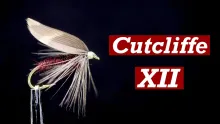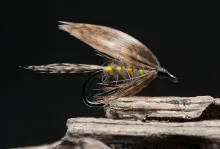The Blue Wing Midge (BWM) is an adult midge pattern designed to be fished wet. The BWM is a fly design that exploits two recent scientific discoveries: The first is that midge wings commonly show colored zones produced by what are called WIPs—Wing Interference Patterns-- these are caused by the same phenomena that you see making colors on soap bubbles. WIPS are common in Diptera and the color pattern seems to be unique to the midge species. The second discovery is that scientific studies show that fully emerged adult midges are increasingly failing to lift off the stream surface because of man-made and natural surfactants (For an example, see the pdf on the web of Takamura, K., 1992, Decrease of Chironomid emergence... by exposure to surfactant ABS..: Japan Journal of Limnology, v. 53, p. 363-373).
So, while increasing pollution is expanding the habitat for midges—as they are more pollution resistant than most aquatic invertebrates, that pollution at the same time is can cause locally reduced surface tension that leads to more of the midges failing at lift-off from the stream surface because they are sinking back underwater and drowning. This is a double bonus situation for a sunken midge adult design--more of them than ever drifting down a river and fish generally feed underwater.
Recipe
Thread: Semperfli Nanosilk 20D black
Hook: I use an extra-wide gape, ring or down-eye hook in a fine or medium gauge wire. My favorite midge hook is the Tiemco 206BL #20 closely followed by the Firehole 316 #18-20.
Bead: 1.5mm black, countersunk. For a more compact head, I put the larger hole of the countersink towards the hook eye unless the bead rides too far over the eye.
Ribbing: fine to very fine silver non-tarnishing wire.
Wing: Two strands each of small transparent blue tinsel and a small pearl tinsel about 3 inches (75mm) long—cut off any kinked portions of the tinsel and use only straight pieces for the wing. I use two colors of tinsel for the wing so that it has the blue, green, orange and magenta tints seen in the wings of the naturals.
Blue Tinsel: The best performer I have found so far is Textreme pearl blue tinsel in the small size (about 0.2mm width) which seems to me the proper width for midge flies. Semperfli Perdigon Body in Iridescent Blue 1/69 inch (0.4mm) is a bit wider but has a good color and also makes an effective fly.
Pearl Tinsel: Hends Holostren pearl tinsel part# HS-10 (about 0.25mm width). I selected this tinsel because it a thin pearl tinsel that is width-appropriate for midge flies.
Tying it: Make a Plan so that you anticipate adding each element without adding any extra wraps of thread that would overly bulk up the fly.
Thread the bead onto the hook. Tie in the thread just behind the bead at the hook eye. Early-on, lash in the wire just behind the bead and wind the thread in a uniform single layer back over the wire to the rear of the hook shank and down a bit into the bend. Ensure that the wire and hook shank are completely covered by a single thin layer of thread to makes a smooth thin uniformly black body under the ribbing.
Wrap the thread forward to just behind the bead. Then take the wire and make an open spiral as you wrap it firmly forward with roughly 0.75mm spacing between the wraps. Wire ribbing adds weight and gives an impression of a segmentation of the abdomen commonly seen in midge adults.
Tie the wire off with three wraps of thread and cut the wire off as close a practical to the hook shank.
Before lashing in the wings, I make several winds of thread just behind the hook eye to make a platform for the wings so that they are not wedged upward by the thickness of the wire ribbing and thread built up behind the bead. This platform allows the wing such to project more or less parallel to the hook shank. Take a straight three inch piece of pearl tinsel. Fold over the piece of tinsel on itself. Lash the middle of this tinsel bundle onto the top of the thread platform behind the bead, fold it over the thread and lash the tinsel bundle down. The goal is to end up with a downwing that lies parallel to the hook shank. Repeat with this procedure for the piece of blue tinsel. If need be put a few wraps of firmly wrapped, but not tightly wound, thread near the base of the wing to lasso the wings so that it stays in a narrow V-shape as well as lying parallel to the hook shank. After the few loose winds I move the winds up to the bead and then apply more force for a couple of turns to prepare for the whip finish. Apply the whip finish just behind the bead where the wings are mounted but use no a head cement which can wick into the wings. Trim the wing so that it is just short of hook bend. Ii needed, I trim off any flared tinsel bits that don't lie along the hook shank and are outside of the narrow v-wing shape that I'm looking for.
Chapters
00:00 Wing Interference Patterns (WIPs)
2:30 Tying a Blue Wing Midge (BWM)
9:45 A BWM Fish Story
11:40 Tying a Dry BWM
- Log in to post comments







